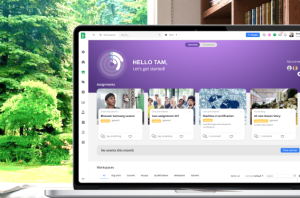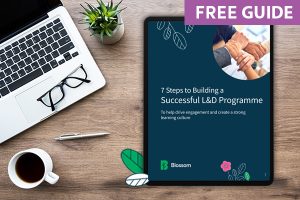Uncover why businesses opt for blended learning as a practical and strategic approach to employee training and development.
The learning and development (L&D) industry has significantly transformed over the past few years. Advances in technology, the global pandemic, and changes in educational practices have forced many businesses to adapt their learning environment. It’s why the growth in the blended learning sector is expected to reach a staggering 6.3 Billion USD by 2030.
While traditional learning methods, such as instructor-led training (ILT), have been a foundational approach to education for a long time, it has many drawbacks.
This blog post will uncover why businesses opt for blended learning as a practical and strategic approach to employee training and development. Learn five reasons to switch from traditional to blended learning approaches.
What is blended learning?
Blended learning is an effective and tactical approach to employee training and development. It combines traditional in-person training with online learning methods to create a flexible learning experience.
Let’s take sales training, for example. Learners complete online modules in their own time that cover topics like new product features and customer relationship management. They watch video demonstrations about managing disgruntled customers and take quizzes at the end of each module to reinforce their understanding.
During the training course, employees also attend a live virtual workshop led by a sales expert. During the workshop, they participate in role-playing scenarios and receive personalized coaching and feedback.
This blended approach combines self-directed online learning with real-time virtual interactions. Employees can apply their skills in a controlled and supportive environment before using them in real-world sales situations.
Furthermore, online resources are available for review even after the in-person sessions have finished–allowing learners to revisit information when needed. In turn, it promotes continuous learning beyond the classroom.
5 reasons you should choose online learning
Investing in on-the-job learning and training and implementing process automation is the top workforce strategy for businesses over the next five years.

Blended learning can play a huge role in enhancing your workforce strategy. You can meet your organization’s and employees’ evolving needs by offering a flexible, responsive, and tailored approach to employee L&D.
Let’s look at five reasons you should consider online training over classic training methods for your workforce.
1. Provides greater flexibility and accessibility
In a traditional classroom setting, interactions between employees and instructors are usually limited by the class size–leaving employees on lengthy waiting lists for the next available course. Without timely training, employees might struggle to meet performance expectations and miss out on opportunities to develop essential skills and competencies needed for their roles.
Classic training methods, like ILT, can raise accessibility challenges for enterprise and mid-sized corporations and their employees. People with disabilities might find traditional training environments less accommodating than online learning methods.
Conventional learning methods often require employees to attend scheduled classes or training sessions, which might not accommodate a modern workforce’s diverse schedules and commitments. When organizations have employees across different work locations, ILT is restrictive.
Let’s put that into practice and say you have employees spread across different geographical areas and time zones.
ILT usually needs employees to travel long distances to attend training sessions–resulting in higher costs related to travel, accommodations, venue rentals, and printed materials. As ILT can be resource-intensive, it is challenging to scale training efforts to accommodate a growing workforce or changing training needs.
Secondly, ILT often follows a standardized curriculum and teaching style, which might not cater to individual employees’ diverse learning styles and paces. Traditional learning methods might not include real examples of work scenarios or provide practical hands-on experiences that employees can directly apply to their roles.
While traditional learning methods can be effective in specific scenarios, such as skills that use specialized laboratory equipment, businesses must consider these challenges and explore more modern and flexible learning approaches.
Blossom is modular, making it highly customizable to fit your organization’s needs. The platform offers solutions for remote working locations, offering:
- Greater convenience. Learners can access course materials and content at their own pace and from any location with an internet connection. This flexibility is particularly beneficial for organizations with a remote and hybrid workforce and employees with busy schedules, jobs, or other commitments.
- Access to self-paced learning: Staff can progress through the material at a pace that suits them. Learners have the autonomy to explore content, participate in online discussions, and conduct research, fostering a sense of ownership over their education. This is especially useful for individuals who want to dive deeper into specific topics or move quickly through familiar concepts. It’s why 82% of learners prefer blended teaching to classic teaching environments.
- Accessible learning opportunities. Flexible learning accommodates different learning styles and needs, making it more accessible to diverse groups, including individuals with disabilities or learning challenges. Learners are also not bound by geographical constraints, such as time zones. They can access learning materials and resources from anywhere and at any time.
2. Personalized learning experience
Did you know that according to eLearning Industry insights, personalized learning is expected to be a significant trend in 2023? Also, restrictive and inflexible learning activities are among the top 10 barriers to learning that L&D Managers face.
Since every learner has unique learning styles and preferences, personalized learning activities adapt to learners’ needs. Employees can leverage their uniqueness and engage in a more effective and impactful learning journey by customizing the learning content, instructional method, and pace.
Interactive assessments and targeted content delivery help employees succeed in their professional development.
In contrast, ILT usually follows a standardized curriculum and timeframe, which might not cater to the specific needs of each learner.
3. Increased productivity
As well as blending learning offering benefits to learners, it also has enormous advantages for businesses.
Allocating physical space, instructors, and resources for in-person training can impact productivity. When employees are off-site to attend ILT, the potential disruptions to regular operations force managers to backfill operations by pulling team members from other departments.
The costs associated with ILT, such as travel and accommodation expenses, venue bookings, and printed handbooks, can add up significantly. Online training eliminates these overhead costs, making it a more budget-friendly option. Additionally, blended learning allows you to scale quickly. Employees can learn during breaks or slower work periods, minimizing downtime. A single blended learning course can cater to a larger audience–reducing costs per learner.
Finally, blended learning programs can lead to faster skill acquisition. Employees can bypass content they are already familiar with and focus on areas that need improvement–boosting productivity.
- “With Blossom, we’re now 100% compliant, both internally and from a legal perspective. Blossom has enabled our learning management team to achieve time and labor cost savings and reduce the time our employees spend on learning.” –Orit Barkama, Learning and Development Manager at SodaStream
While implementing flexible e-learning systems might involve initial investments, the long-term benefits are enormous. Reduced training costs and better use of resources increase overall productivity–creating an engaging and learner-centered educational experience.
4. Enhanced engagement
Picture this. Your organization needs help finding a suitable venue for the next health and safety course. The pressure is on finding a location that meets your workforce needs. Still, you know that some employees will need to travel afar or be unable to attend due to family commitments–incurring costs and the risk of non-compliance.
As traditional learning methods can affect engagement, blended learning options offer a way to improve learner engagement by:
- Improving loyalty. Long waiting times for training can leave employees feeling stagnant in their careers. They may perceive a lack of investment in their professional growth, leading to decreased loyalty to the organization.
Creating a continuous learning culture is one of the top four focus areas for L&D leaders. Enhance employee loyalty to your organization by offering a blended learning approach. Help your workforce recognize the investment in their development and well-being.
- Enhancing learner knowledge. Research suggests that traditional classroom-based learning methods can lead to lower retention rates and reduce knowledge compared to more interactive and experiential approaches.
Blended learning offers many different ways learners can increase their skills. From discussion forums and simulations to hands-on workshops and online games and activities, employees can acquire new skills and retain new knowledge. Learners are encouraged to support each other by asking questions and sharing insights.
- Boosting motivation. According to Gallup, employee non-engagement costs businesses $7.8 trillion. Learners can perceive traditional training as monotonous or irrelevant to their roles. A machine operator, for example, may think learning in a classroom is inappropriate and irrelevant.
Blended learning gives everyone a more interactive and technology-enhanced approach. Blended learning keeps learners engaged and motivated by combining various teaching methods relevant to a job role, such as online videos and hands-on activities.
But don’t take our word for it.
As well as needing help with compliance requirements, SodaStream struggled with employee participation. Learner engagement was inconsistent–causing missed compliance completion dates and a lack of enhancing skills.
Blossom streamlined workflows and helped the world-famous sparkling water company maintain its global workforce training needs quickly and efficiently–from one centralized platform. Blossom’s fully accessible portals and blended learning activities made employees feel valued and cared for.
Create a well-rounded educational experience for your employees. Offer learners a mix of technology, interactive experiences, and real-world situations aligned with how modern employees prefer to learn.
5. Make data-driven decisions
Classic learning methods often lack the data-driven insights that online learning platforms offer–making it harder to track employee progress and assess the effectiveness of the training.
Blended learning technologies generate data that can help you identify learning patterns, areas of difficulty, and training effectiveness. This data can provide valuable insights that help make informed decisions to improve L&D strategies.
Collecting data on training completion rates, assessment scores, and learner satisfaction gives you an overview of the effectiveness of learning events.
On the other hand, if a training event consistently results in poor outcomes, such as low engagement and poor learner satisfaction ratings, it might need revision or replacement.
Secondly, as blended learning provides real-time tracking and analytics features that give immediate feedback, employees and trainers can gauge understanding in real-time. This prompt feedback helps people identify strengths and areas for development without undue delay.
Lastly, online learning data helps to identify high-potential employees who are proactive in pursuing training opportunities. Since 83% of businesses believe developing leaders is important, only 5% have implemented leadership development at all levels.
Make better strategic decisions. Get the data to support talent development with blended learning analytics and insights to support succession planning efforts.
Make the transition to blending learning
As technology continues to shape how we learn and develop new skills, online training has emerged as a versatile and effective method that compliments traditional ILT.
The flexibility, personalization, cost-effectiveness, and data-driven insights offered by blended training make it a perfect choice for learners and organizations. While ILT still holds its place, integrating a blended learning approach can provide a richer and more engaging learning experience.
Ready to learn more? Start building your blended learning strategy with Blossom. Schedule a demo today.








